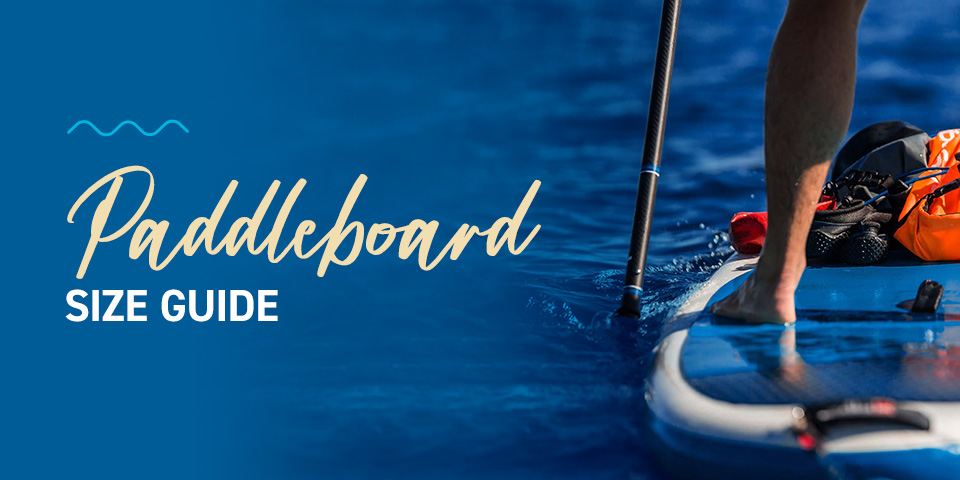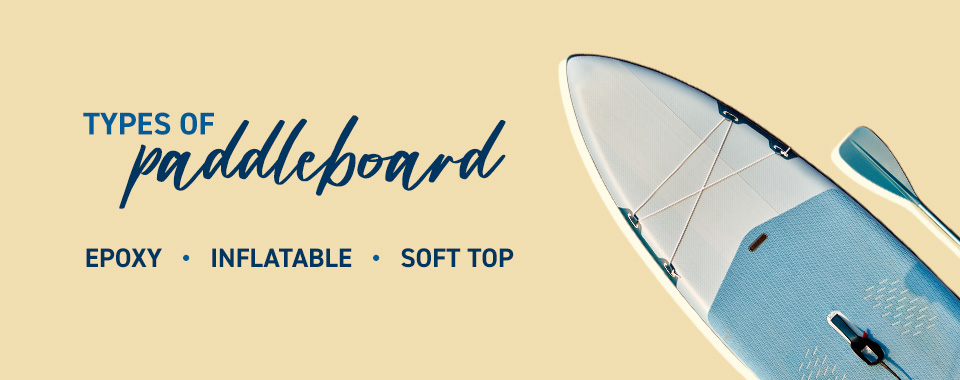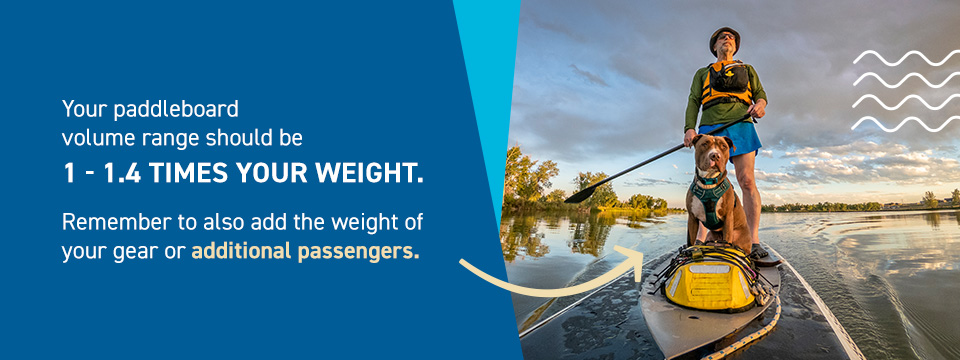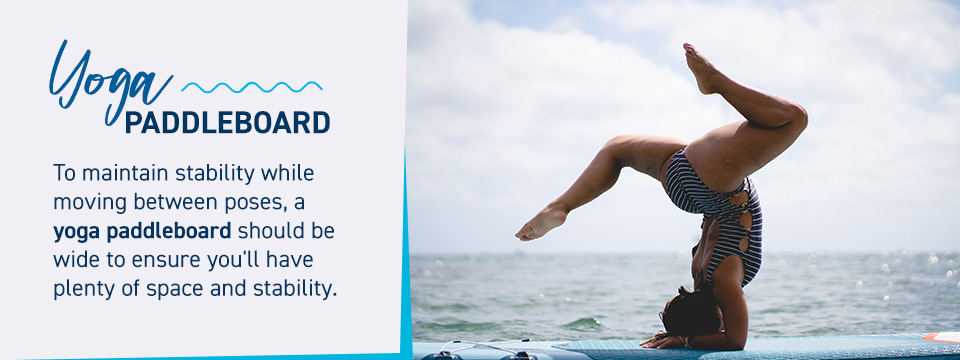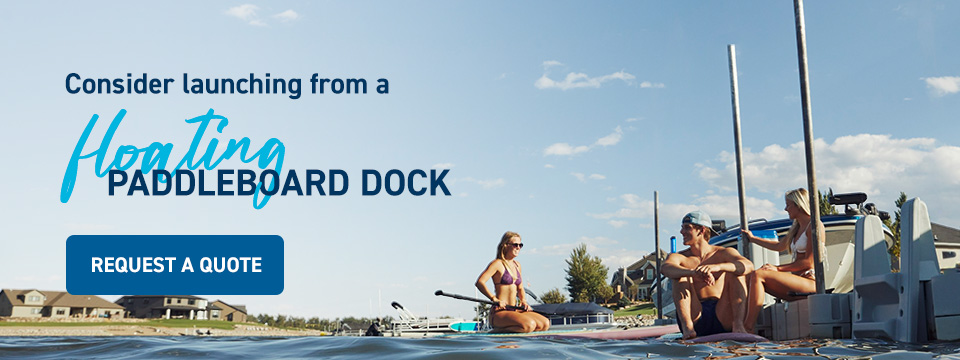Filters
Paddleboard Size Guide
If you’re in the market for a new paddleboard, you may be asking yourself, “What size paddleboard do I need?” There are numerous factors that will affect paddleboard sizing, so it’s important to understand how to determine the best size for your needs. Keep these tips and considerations in mind when shopping for your next paddleboard.
How Length Affects Paddleboarding
Paddleboard lengths typically range from 9-12 feet. The length of your paddleboard can impact various aspects of your paddleboarding experience, like maneuverability. Maneuverability refers to how easily you can move or steer your paddleboard in the water. The length of your board has one of the biggest impacts on maneuverability.
In general, shorter boards are easier to maneuver. Because short paddleboards allow for quicker turns and movements, they’re typical in racing. Using a short paddleboard does require some experience, so advanced paddlers generally use them.
Paddleboards used for touring, recreation and beginning paddlers are typically a bit longer. The extra length provides additional stability and is generally easier for beginners to learn with. However, length is important to consider because too long of a board can be more difficult to maneuver.
This should be kept in mind depending on the desired use for your board. If you’re a beginner looking for leisure time on the water, a bit more length is harmless. If you’re more advanced and want to cruise around or need to maneuver your board through tight spaces, you may opt for a shorter board.
How Width Affects Paddleboarding
One of the biggest aspects of paddleboarding is balance. Water surfaces are far from stable and your board will move and rock with the water. Standing on top of a paddleboard puts you pretty high above the water without a strong center point of gravity. To remain on your board, you’ll need strong balance. However, the width of your board can also affect how much stability you have when paddleboarding. Narrow boards offer less stability and wider boards offer more stability.
A narrow paddleboard has a width of 30 inches or less. Narrow paddleboards offer less space for you to distribute your weight, which requires more experience to remain balanced on the water. Narrow paddleboards also offer more speed, as paddlers can more easily maneuver their boards. Because of the lack of general stability that narrow paddleboards have, they’re best suited for and often preferred by more experienced paddlers.
A paddleboard wider than 31 inches is considered a wide board. The wider your paddleboard, the more stability you’ll have on the water. Wide boards are perfect for beginners, as the added stability allows the user to get comfortable with their balance as they learn to paddleboard. Wider paddleboards won’t move as fast in the water, though they will provide a smoother paddling experience, especially in rougher waters.
Wider paddleboards also provide additional deck space, allowing you to bring snacks, water, clothes and other gear on the board without being cramped. Wide boards are also great options for paddlers who may like to paddle with pets, friends or a significant other — some paddleboards are wide enough for two users.
Factors Affecting What Size to Choose
When paddleboarding, it’s important to choose an appropriately sized board to have an enjoyable experience. However, more factors than length and width can affect what size board will be best for you. Consider how these factors can affect your paddleboard sizing to ensure you’re choosing the best fit.
Type of Paddleboard
The type of paddleboard you’re using can impact the size board you’ll use. The type of board may affect the size you choose for a few reasons, including how you’ll store the paddleboard and how much stability you need. There are three main types of paddleboards:
- Epoxy: Epoxy paddleboards have layers of foam and fiberglass, and epoxy resin creates a smooth topcoat. Epoxy is the traditional material used to make surfboards, and since surfboards and paddleboards are closely related, it’s an effective material for paddleboards. Epoxy boards are stiff and rigid, making them great for gliding on the water and tackling waves. However, their size and rigid form make them difficult to transport and store.
- Inflatable: Inflatable paddleboards are relatively new, though they quickly gained popularity. When it comes to inflatable paddleboards, size isn’t an issue in terms of transporting and storing them because the board can easily be deflated and rolled up. Despite being inflatable, these boards are made of PVC layers, making them sturdy and durable. Inflatable paddleboards tend to be on the bigger side, making them great options for recreational paddleboarders and beginners.
- Soft top: Soft top paddleboards have a sponge-like top deck while the core is made of dense foam to provide strength and stability. Soft top boards tend to be less maneuverable and only come in one shape, which means there are less options in terms of sizes. These features make them great options for beginners. They also tend to be heavier than other types of boards.
The type of paddleboard you use can affect the board size because the different types are made of different materials, which means they’ll vary in terms of weight, thickness, shape and more. These aspects of a board can significantly affect the board size.
Weight Capacity
All paddleboards have a suggested weight limit to help ensure safe and effective use. Your weight will help you determine what size paddleboard is best for you. Your weight should be at or under the paddleboard’s weight limit. It’s not possible to be “too light” for a paddleboard, though following the suggested weight limit will help the paddleboard glide efficiently in the water. Exceeding a board’s weight capacity makes the board sit lower in the water, causing drag. A dragging board is both inefficient and more difficult to paddle.
Your paddleboard should be able to support your weight, which will make it easier to balance while paddling. If you’re a beginner, this aspect will make a significant difference in helping you learn to balance and maneuver through the water. If you plan to paddleboard with kids, friends, pets and additional gear on the board with you, their weights should be added to the total weight.
Epoxy and soft top paddleboards are rigid enough that exceeding their weight capacities would cause the entire board to ride low in the water. While inflatable paddleboards are sturdy, exceeding their weight limits can cause what some refer to as the “taco effect.” When the inflatable paddleboard can’t support the paddler, the middle may sit lower in the water, causing the ends to float higher and even stick out of the water. Thicker inflatable paddleboards will support more weight.
Weight Capacity Calculation
While most paddleboard manufacturers provide a suggested weight capacity, there is another way you can use your weight to calculate what size board you should get. A paddleboard’s buoyancy is measured by volume, which calculates how much weight a board can hold. Paddleboard volume is measured in liters, so you can use your weight to determine a volume range you should look for in a paddleboard. Ideally, your paddleboard volume range should be 1-1.4 times your weight.
For example, a paddler that weighs 160 pounds would multiply her weight by 1 and 1.4. This equals 160 and 224, which will be the volume range she should look for. This paddler should choose a paddleboard with a volume in the range of 160-224 liters to ensure the board is properly sized for her weight.
Remember to also add the weight of your gear or additional passengers. For example, if the paddler in the above example plans to paddleboard with her 15-pound dog, she should add the dog’s weight to her weight before multiplying. So with her dog in mind, this paddler should look for a paddleboard with a volume in the range of 175-245 liters.
Keep in mind that in many cases, it’s best to opt for a bit more volume just to be safe. Rather than choosing a paddleboard at the bottom of your suggested volume range, size up to account for extra stability and support. This also gives you some wiggle room in case you decide to carry more gear.
Board Thickness
Board thickness is easy to overlook, though it’s a crucial sizing factor. Paddleboard thickness can vary, though they’re commonly between 4-6 inches thick. Paddleboard thickness correlates with the weight capacity. Thicker boards can support more weight than thinner boards, though thinner boards are easier to maneuver.
If you need the weight support, a thicker board is necessary and any disadvantages like less maneuverability are a fair tradeoff. Thicker boards are also preferable for new paddleboarders, as the thickness provides more stability in the water. More experienced paddleboarders typically opt for a thinner board, though the thickness will ultimately depend on how much extra volume you need.
Activities
One of the biggest factors impacting the size of your paddleboard is its intended use. Paddleboards are great for a wide range of activities, from white water paddling to yoga. Some paddleboard sizes are better for certain activities than others. If you’re looking for a paddleboard that will allow you to try different activities, a board that’s 10.5-11.5 feet long and 31-35 inches wide will be versatile. If you’re looking for an activity-specific board, consider the following size recommendations:
- Touring: One of the most common paddleboard activities is called touring. This activity involves long-distance paddling, often to explore bodies of water and the surrounding areas. Touring boards are relatively versatile and offer speed when paddling. These boards are generally longer than other types of boards and should be at least 11 feet long. Touring boards are usually between 30-33 inches wide to provide stability when gliding through the water.
- Yoga: Paddleboard yoga has recently grown in popularity, as it offers an effective workout while relaxing on the water. Yoga on solid ground requires a certain level of balance, so the need for balance is doubled when standing on water. To maintain stability while moving between yoga poses, a yoga paddleboard should be wide — around 31-35 inches — to ensure you’ll have plenty of space and stability. A standard length of 10-11.5 feet is adequate for this activity.
- Fishing: You can fish from any paddleboard, though there are specific fishing paddleboards that provide the necessary width and volume for carrying fishing gear. Baits and tackle can add some serious weight to your board. Casting and reeling your line can cause shifts in balance, so a wider board can help stabilize you. In terms of length, 10.5-12 feet is common for fishing-specific paddleboards. The board should also be at least 32 inches wide. In terms of weight capacity, be sure to look for a board with plenty of volume, which could be sizing up.
- Surfing: If you’re an experienced paddleboarder, you may try paddleboard surfing. Surf paddleboards are short — typically around 9-10.5 feet — to offer maximum maneuverability when riding waves. Surf paddleboards are also not as wide as others, helping you lean with the waves. As an experienced paddleboarder, your balance will naturally be better than a beginner’s, so you’ll still be able to paddle short, narrow boards on flat water.
- River paddling: For paddlers seeking a thrilling adventure, whitewater paddleboarding has become a new way for experienced paddlers to enjoy the rivers. The best type of board for this activity will be even shorter than surfing paddleboards, measuring around six to eight feet long. They should be pretty standard in terms of width, staying between 30 and 34 inches to stay stable while navigating rapids. You may also want to opt for an inflatable paddleboard, as they’ll be a bit more flexible in moving water.
Other Important Factors When Choosing a Paddleboard
There is a wide variety of paddleboards on the market, so there are many factors to consider when choosing one to ensure the board you get is good for your needs. In addition to the factors above, here are three more important factors to consider when choosing a paddleboard:
- Board shape: Paddleboards either have fat, wide or narrow, pointy nose and tail shapes. In most environments, a wider nose shape will provide more stability. However, if you plan on paddling through waves, a board with a narrow nose will allow you to cut through choppy water while maintaining stability.
- Board weight: Be sure to consider the board’s weight and how it will affect your ability to paddle and maneuver in bodies of water. Too heavy of a board can be more difficult to paddle, while a board that’s too light may experience a loss of performance in rough water. It’s also important to consider how you’ll store and transport your paddleboard, as you may have to lift and carry the weight.
- Price: The materials, size, type of board and more can all affect the price of a paddleboard. Be sure to set a budget so you’re not overspending. If you’re a beginner, note that there are plenty of affordable, quality options without having to spend a fortune.
Choose the Right Size Paddleboard for You
Choosing the right size paddleboard will enhance your experience on the water. Whether you’re learning to paddleboard or have some experience under your belt, launching your paddleboard tends to be a bit tricky. To simplify and improve your transition on and off a body of water, consider launching from a floating paddleboard dock by EZ Dock. Perfect for properties on lakes, rivers and oceans, floating paddleboard docks make it easy to take your paddleboard out.
To learn more about our paddleboard floating docks, contact us today. To find out how to customize our floating docks, request a quote.

